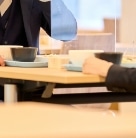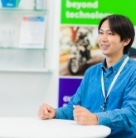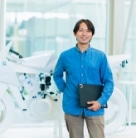
TWO-WHEELER &
POWERSPORTS
BUSINESS UNIT
Yuki O.
Engineering Department, Engineering Integration
System Safety Development
SW Engineer
Joined Bosch in 2012
Originally had little interest in motorcycles. Discovering the joy of riding and developing riding assistance systems.
When I was a student, I joined the automotive club, and I became fascinated with automobiles. In my previous job, I was involved in the development of the SW platform that forms the basis of in-vehicle car navigation systems. Although it was very rewarding, I did not have many opportunities to interact with actual vehicles. I decided to join Bosch mid-career because I wanted to work at the leading edge of automotive safety systems.
As I had hoped, I was assigned to a department related to vehicle control, but I was put in charge of motorcycles, not automobiles. To be honest, I can't deny that before I came to Bosch, I was more interested in cars than motorcycles, and I had the image that motorcycles were "dangerous vehicles". However, after I obtained my motorcycle license and started riding on my own, I became fascinated by the joy of riding when I came to understand the key points for safe riding and became aware that a motorcycle is "a vehicle with more freedom than a car".
Initially, I was in charge of the control area of brake systems, but I stepped forward to be involved in riding assistance systems that had just begun development. Since then, I have been in charge of the development of ARAS (Advanced Rider Assistance Systems), a state-of-the-art rider assistance system for motorcycles. Functions that have become commonplace in four-wheeled vehicles (such as adaptive cruise control (ACC), which accelerates and decelerates the speed according to the vehicle in front, blind spot detection, and collision prediction warning), are implemented to suit the characteristics of motorcycles.

Japan is the base for advanced development of assistance systems. Therefore, everything can be consistently performed from function development to actual vehicle testing.
The Two-wheeler & Powersports Business Unit, which develops ARAS, just became an independent organization in 2015. The special feature of this is that Japan plays an important role as the headquarters and an advanced development base for assistance systems. For this reason, we can perform the entire flow of function development ourselves. For example, while riding a motorcycle we may get an idea like, "I wish there was a function like this." We can do the coding ourselves and install the software on the vehicle, and then test and evaluate it on an actual vehicle. I think a major attraction of Bosch's Two-wheeler & Powersports Business Unit is the environment in which development can be done with the special basis of being able to "evaluate what we have created ourselves".

Until now, there had been a deeply rooted idea that "motorcycles are something people enjoy riding, so there is no need for driver assistance systems". ARAS has features that contribute to reducing accidents while enjoying riding, and has the potential to help riders find new values in motorcycles. Our role is to further refine the already established system for automobiles, and pursue functions that are suited to the behavior of motorcycles.
I was assigned to Germany for about three years from 2018 for its early introduction in Europe. I was involved in meetings to discuss functions, development, and actual vehicle tests, with local motorcycle manufacturers, which are our customers. The interesting part of rider assistance systems is that they need to be tested on open roads according to local traffic conditions. Together with our customers, we rode around the German Autobahn and urban areas, and created functions that no one had ever experienced. It was an exciting experience like no other.

Movement unique to motorcycles is reflected in the system. Functions that you created can reduce accidents.
Motorcycles and automobiles differ greatly in the way the vehicle body behaves. The technical feature of ARAS is that it uses an inertial measurement sensor unit (IMU) to provide precise riding assistance according to the vehicle's driving conditions. Because the behavior of motorcycles is different from that of automobiles, the developers themselves reflected their own experience of riding motorcycles, and incorporated ideas into the software to make functions that are safe and that end-users would want to use.
Members from various countries such as India, Australia, Romania, and Germany are involved in each function. There are many motorcycle lovers and everyone is highly motivated to work. On the other hand, a female developer colleague of mine was not a motorcycle enthusiast, but as she worked, her desire to evaluate its functions firsthand became stronger. So she obtained a driving license and is also engaged in driving training. The environment where you can be in charge of everything, from function development to actual vehicle testing, has great appeal and even people who are not interested in motorcycles will get hooked.
Motorcycles are now equipped with a large number of electronic devices, and systems are becoming more complex. How can we create functions that are simple and useful to riders? The real thrill of the Two-wheeler & Powersports Business Unit is being able to create with your own hands the functions that no one has ever seen before. In order to make motorcycles, which provide a "feeling of freedom" in riding, more enjoyable and safer, we will further enhance ARAS and pursue the development of systems that reduce accidents in society as a whole.














